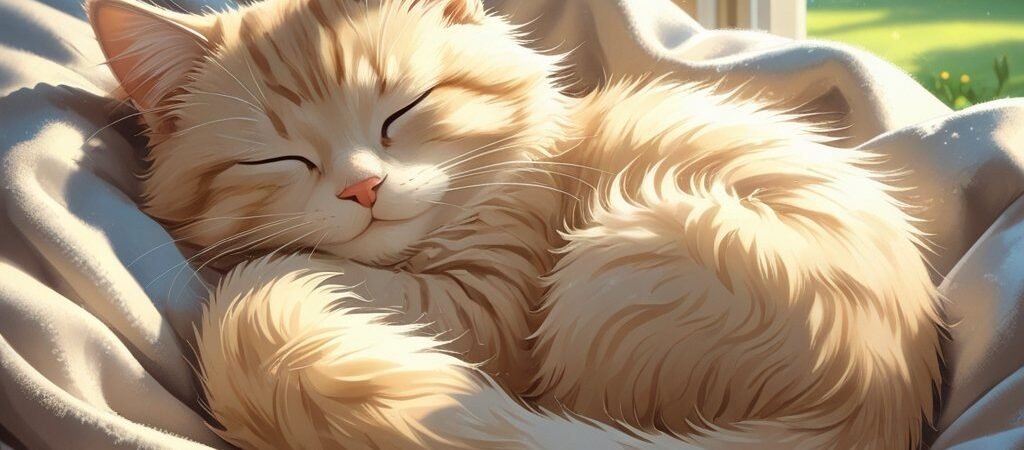Meta Description: Discover if cats dream and explore fascinating feline sleep habits. Learn about REM sleep in cats, sleep patterns, and what your cat’s dreams might contain.
Have you ever watched your sleeping cat and noticed their whiskers twitching, paws paddling, or soft mewing sounds escaping their lips? These adorable movements often make cat owners wonder: are cats actually dreaming, and if so, what could they possibly be dreaming about?
The world of feline sleep is far more complex and fascinating than most people realize. Cats are among the champion sleepers of the animal kingdom, spending an impressive 12-16 hours per day in various stages of sleep. But there’s much more to cat sleep than just long napping sessions – their sleep patterns, dream states, and behavioral quirks during rest reveal incredible insights into feline biology and psychology.
Understanding your cat’s sleep habits can help you provide better care, recognize potential health issues, and appreciate the remarkable adaptations that make cats such successful predators. Let’s explore the mysterious world of cat dreams and uncover the secrets behind those marathon sleeping sessions.
The Science of Cat Sleep: Do Cats Actually Dream?
The short answer is yes – cats do dream! Scientific research has confirmed that cats experience REM (Rapid Eye Movement) sleep, the stage most associated with vivid dreaming in humans and other mammals.
Understanding Feline REM Sleep
Studies using electroencephalogram (EEG) technology have shown that cats exhibit brain wave patterns during sleep that are remarkably similar to those observed in humans during REM sleep. During these periods, cats show:
- Rapid eye movements beneath closed lids
- Increased brain activity similar to waking states
- Temporary muscle paralysis that prevents them from acting out their dreams
- Irregular breathing patterns
- Fluctuating body temperature
This REM sleep typically occurs in cycles throughout their sleeping period, with cats spending about 15-25% of their total sleep time in this dream state. 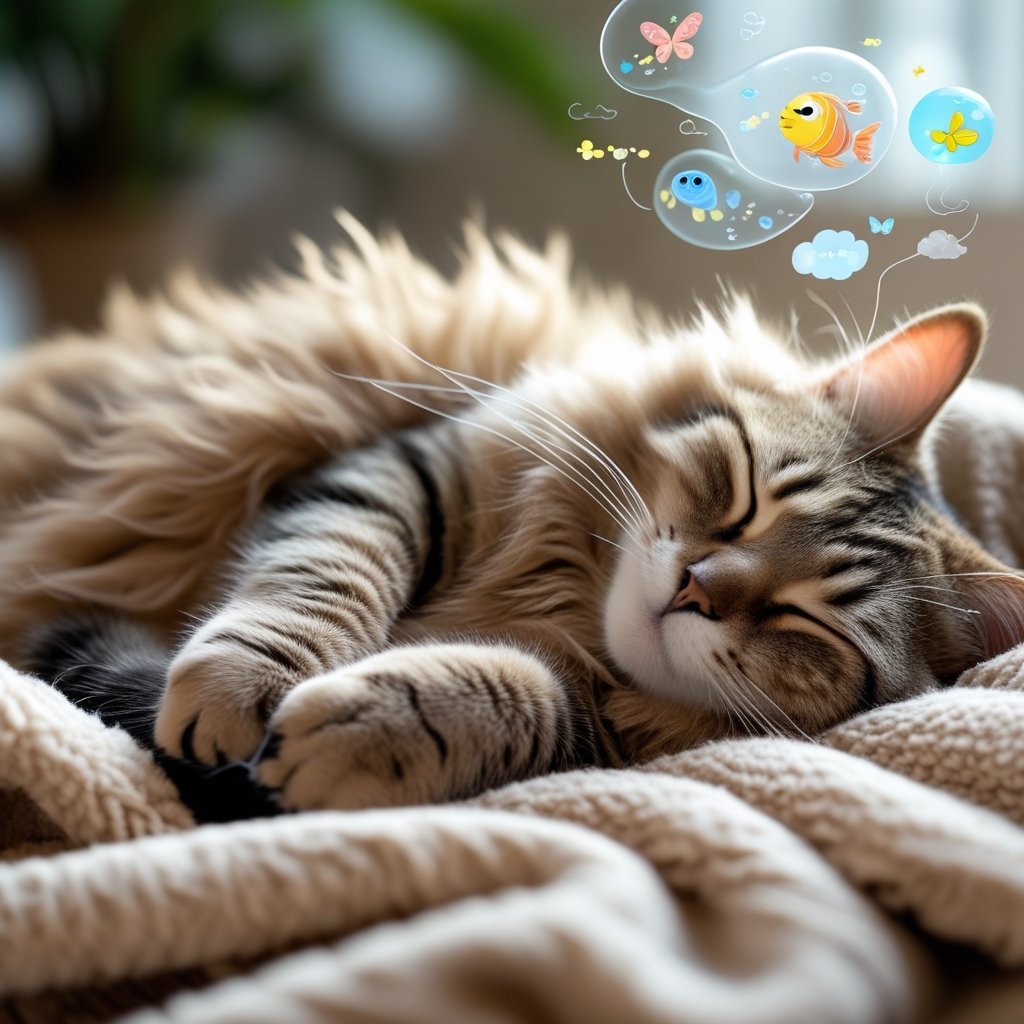
What Might Cats Dream About?
While we can’t ask cats to describe their dreams, researchers have made educated guesses based on brain activity patterns and observable behaviors during REM sleep. Cats likely dream about familiar activities and experiences from their daily lives:
Hunting and Predatory Behavior: The most common dream content probably involves stalking, chasing, and catching prey. This explains the paddling paw movements and whisker twitching often observed during cat dreams.
Social Interactions: Cats may dream about interactions with their human family members, other pets, or territorial encounters with neighborhood cats.
Exploration and Play: Dreams might include memories of investigating new spaces, playing with favorite toys, or climbing and jumping activities.
Routine Activities: Even mundane activities like eating, grooming, or finding the perfect napping spot might appear in feline dreams.
Cat Sleep Patterns: The Ultimate Sleeping Champions
Cats have evolved unique sleep patterns that reflect their natural hunting behaviors and energy conservation needs.
Total Sleep Requirements
Most adult cats sleep 12-16 hours per day, with some cats sleeping up to 20 hours daily. This extensive sleep schedule isn’t laziness – it’s an evolutionary adaptation that serves several important purposes:
Energy Conservation: Wild cats need to conserve energy between hunting sessions, as successful hunts require intense bursts of speed and agility.

Predator Adaptation: As crepuscular animals (most active during dawn and dusk), cats sleep during the day when their natural prey is less active.
Growth and Recovery: Sleep is crucial for muscle recovery, immune function, and overall health maintenance.
Sleep Cycle Stages
Cat sleep consists of two main phases, similar to human sleep patterns:
Light Sleep (Non-REM): Cats spend about 75% of their sleep time in light, dozing sleep where they remain somewhat alert to their surroundings. During this phase, they can wake quickly if needed.
Deep Sleep (REM): The remaining 25% involves deep, REM sleep where dreaming occurs. This is when you’re most likely to observe those adorable dream movements.
Cats typically cycle through these phases every 25-30 minutes, allowing them to rest deeply while maintaining readiness to respond to potential threats or opportunities.
Age-Related Sleep Differences
Sleep patterns vary significantly based on a cat’s life stage:
Kittens (0-4 months): Sleep 18-20 hours per day, with higher percentages of REM sleep crucial for brain development and growth.
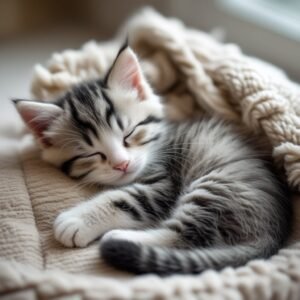
Young Adult Cats (6 months-7 years): Maintain the typical 12-16 hour sleep schedule with regular REM cycles.
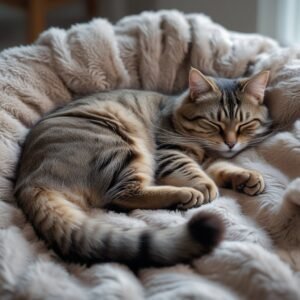
Senior Cats (7+ years): Often sleep more hours overall but may have more fragmented sleep with frequent wake periods and potentially less REM sleep.
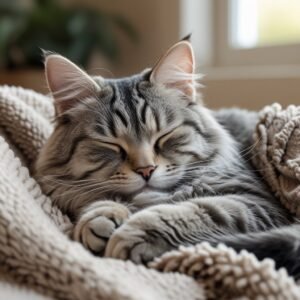
The Fascinating World of Cat Napping Behaviors
Cats have developed numerous interesting behaviors and preferences related to their sleeping habits.
Preferred Sleeping Positions
Each cat sleeping position serves specific purposes and reveals information about their comfort level and temperature needs:
The Classic Loaf: Paws tucked under the body, indicating alertness and readiness to move quickly while still resting.
Curled in a Ball: Maximum warmth conservation, often seen in cooler environments or when cats feel the need for security.
Stretched Out Full Length: Indicates complete relaxation and trust in their environment, often chosen in warm conditions for heat dissipation.
The Belly-Up Position: Shows ultimate trust and comfort, though cats rarely stay in this vulnerable position for long periods.
Side Sleeping: A comfortable middle-ground position that allows for easy movement while providing adequate rest.
Location Preferences
Cats are notoriously particular about where they choose to sleep, and their preferences often change based on various factors:
Temperature Regulation: Cats seek warm spots in cool weather (sunny windows, heating vents, warm laundry) and cooler areas during hot weather (tile floors, basement areas).
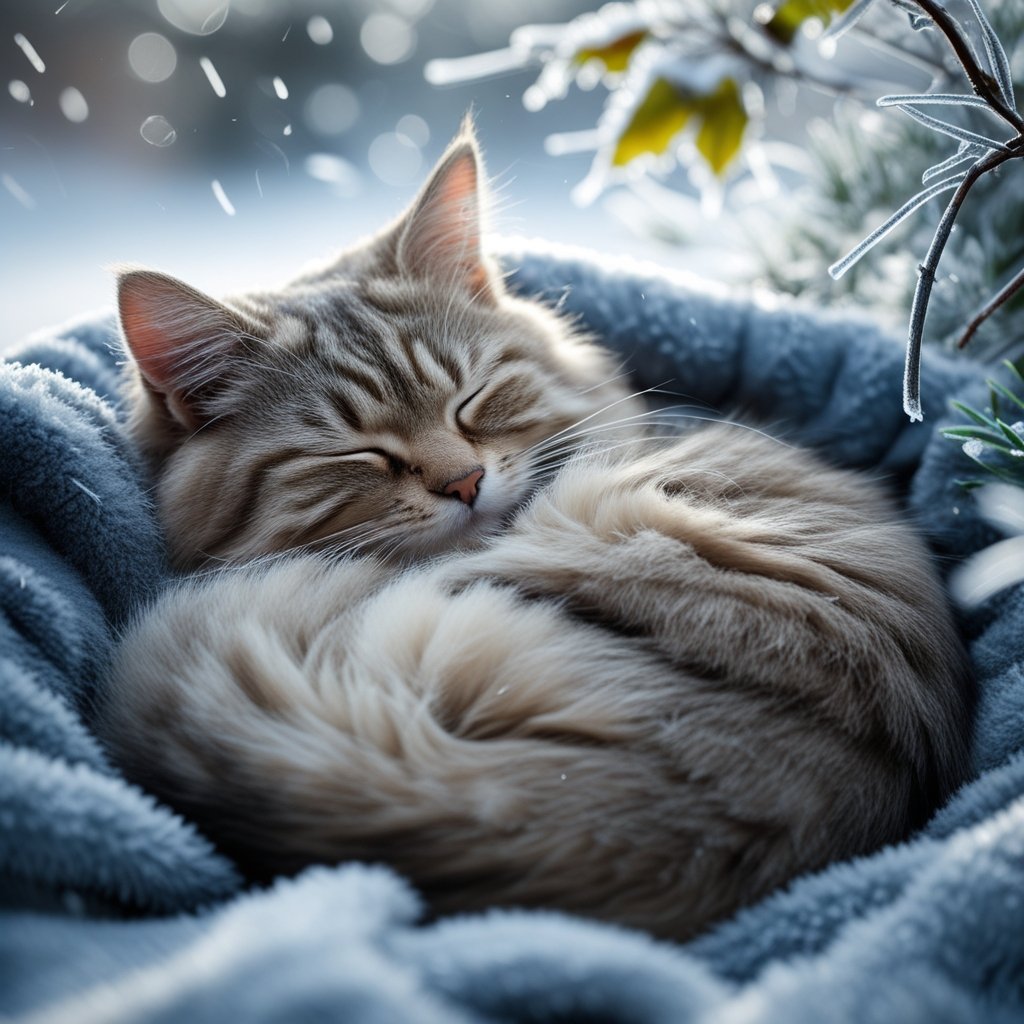
Security Needs: Many cats prefer elevated sleeping spots or partially enclosed areas that provide security while allowing observation of their territory.
Social Factors: Some cats prefer sleeping near their human family members, while others seek out solitary spots for undisturbed rest.
Routine and Familiarity: Cats often develop strong preferences for specific sleeping spots and may become stressed if access to preferred locations is restricted.
Signs Your Cat Is Dreaming
Learning to recognize when your cat is dreaming can be both entertaining and informative for understanding their sleep quality.
Physical Dream Indicators
Whisker Movement: Twitching whiskers often indicate active dreaming, possibly involving hunting or exploration activities.
Paw Paddling: Running or kneading motions with paws suggest dreams involving movement, hunting, or comfort-seeking behaviors.
Facial Expressions: Subtle changes in facial expression, including ear movements or slight mouth movements, can indicate dream activity.
Tail Twitching: Gentle tail movements during sleep often accompany active dream states.
Eye Movements: You might notice rapid eye movements beneath closed eyelids during REM sleep phases.
Vocal Dream Expressions
Many cats vocalize during dreams, producing sounds that can include:
- Soft chirping or chattering (possibly dreaming about birds)
- Quiet mewing or meowing (social interaction dreams)
- Purring (contentment or comfort-related dreams)
- Soft growling (territorial or hunting dreams)
These vocalizations are typically much quieter than waking sounds and shouldn’t cause concern unless they become frequent or distressing.
Creating the Optimal Sleep Environment for Your Cat
Understanding cat sleep needs can help you create an environment that promotes healthy, restful sleep.
Comfortable Sleeping Options
Multiple Choice Locations: Provide several sleeping options throughout your home to accommodate changing preferences and temperature needs.
Elevated Options: Cat trees, shelves, or elevated beds satisfy cats’ preferences for high vantage points.
Enclosed Spaces: Cat caves, boxes, or beds with raised sides provide security for cats who prefer enclosed sleeping areas.
Temperature Variety: Ensure your cat has access to both warm and cool sleeping spots to accommodate their temperature regulation needs.
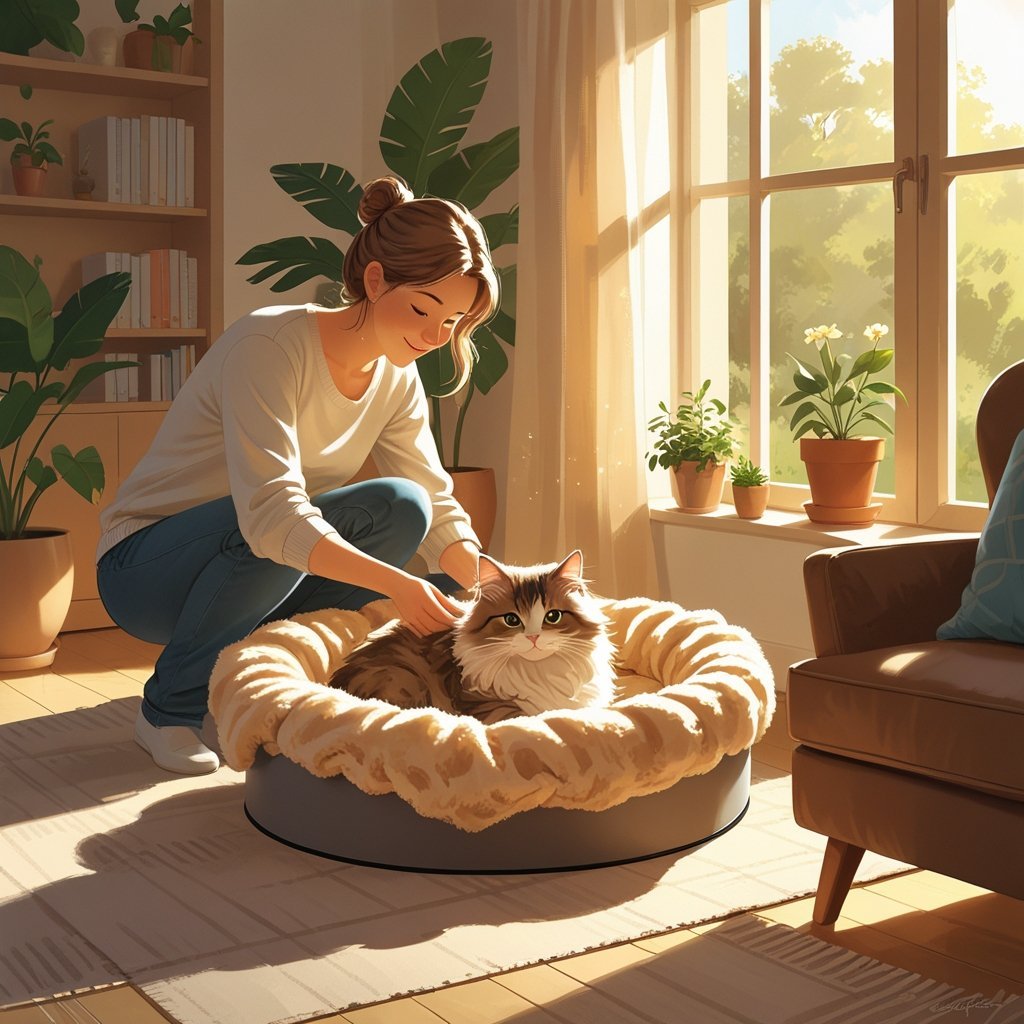
Sleep Schedule Considerations
Respecting Natural Rhythms: Don’t worry if your cat is most active during dawn and dusk – this is natural crepuscular behavior.
Quiet Sleep Areas: Provide access to quiet areas where your cat can sleep undisturbed, especially during their deep sleep phases.
Consistent Routine: While cats are adaptable, maintaining consistent daily routines can help promote healthy sleep patterns.
When Cat Sleep Patterns Signal Health Issues
Changes in sleep patterns can sometimes indicate underlying health problems that require veterinary attention.
Warning Signs to Watch For
Excessive Sleep: While cats naturally sleep a lot, sudden increases in sleep duration or difficulty staying awake during typically active periods could indicate illness.
Sleep Disruption: Frequent waking, restlessness, or inability to settle into sleep patterns may suggest pain, anxiety, or medical issues.
Vocalization Changes: Increased crying, howling, or distressed sounds during sleep could indicate discomfort or cognitive issues, especially in senior cats.
Location Changes: Sudden avoidance of preferred sleeping spots or choosing unusual locations (like hiding) might indicate illness or stress.
Movement Difficulties: Trouble getting comfortable, frequent position changes, or stiffness when waking could suggest arthritis or other physical discomfort.
Age-Related Sleep Changes
Senior Cat Considerations: Older cats may experience sleep pattern changes due to cognitive decline, arthritis, or other age-related conditions. Increased vocalization during sleep, disorientation upon waking, or dramatic schedule changes should be evaluated by a veterinarian.
Kitten Sleep Monitoring: Very young kittens who don’t sleep adequate amounts or seem excessively lethargic may need medical evaluation.
The Evolution of Cat Sleep Patterns
Understanding why cats evolved such extensive sleep requirements provides insight into their natural behaviors and needs.
Wild Cat Heritage
Predator Energy Conservation: Wild cats must conserve energy between hunting sessions, as unsuccessful hunts mean expended energy without caloric reward.
Prey Activity Patterns: Since small mammals and birds are most active during dawn and dusk, cats evolved to be alert during these periods and rest during midday and nighttime hours.
Safety Considerations: Sleeping during daylight hours when larger predators are less active provided safety advantages for wild cat ancestors.
Modern Domestic Adaptations
Food Security Impact: Indoor cats with reliable food sources still maintain ancestral sleep patterns, even though energy conservation is less critical for survival.
Environmental Adaptation: House cats have adapted to human schedules to some degree but retain strong preferences for crepuscular activity periods.
Social Sleep Evolution: Many domestic cats have developed preferences for sleeping near their human family members, showing adaptation to social living situations.
Frequently Asked Questions About Cat Sleep and Dreams
Q: Is it normal for my cat to twitch and move while sleeping?
A: Yes, gentle twitching, paw movements, and whisker movement during sleep are completely normal and indicate healthy REM sleep and dreaming activity.
Q: Should I wake my cat if they seem to be having a nightmare?
A: Generally, it’s best not to wake a dreaming cat unless they appear genuinely distressed. The muscle paralysis during REM sleep prevents cats from acting out dreams dangerously, and brief movement is normal.
Q: Why does my cat sleep so much more than my dog?
A: Cats have evolved as energy-conserving predators who need rest between intense hunting activities, while dogs evolved as endurance hunters with different energy patterns. This difference remains even in domesticated animals.
Q: Do indoor cats dream differently than outdoor cats?
A: While we can’t know the specific content of cat dreams, indoor and outdoor cats likely dream about their respective experiences – indoor cats might dream more about toys and household activities, while outdoor cats might have more varied hunting and exploration dreams.
Q: Can cats have insomnia like humans?
A: Yes, cats can experience sleep disruptions due to stress, medical conditions, environmental changes, or age-related issues. Persistent sleep problems should be evaluated by a veterinarian.
Conclusion: Appreciating Your Cat’s Sleep World
The answer to “Do cats dream?” is a definitive yes, and their dream world is likely filled with the activities, experiences, and instincts that make up their daily lives. From hunting adventures to social interactions, your cat’s dreams probably reflect the rich inner life that makes them such fascinating companions.
Understanding your cat’s sleep patterns and dream behaviors helps you appreciate the complex biology behind those seemingly simple napping sessions. Those adorable twitches, soft mews, and paddling paws aren’t just cute quirks – they’re evidence of a sophisticated nervous system processing the day’s experiences and maintaining cognitive health through rest.
By respecting your cat’s extensive sleep needs and providing comfortable, safe sleeping environments, you’re supporting not just their physical health but also their mental and emotional wellbeing. The next time you see your cat curled up for another marathon napping session, you’ll know they’re not being lazy – they’re following millions of years of evolutionary programming while possibly dreaming about their next great adventure or that particularly interesting bird they saw outside the window.
Sweet dreams to both you and your feline friend, and remember that those sleeping hours are just as important to your cat’s health and happiness as their waking moments of play and affection.
What interesting sleep behaviors have you observed in your cat? Share your sleeping cat stories in the comments below!
Want to create the perfect sleep environment for your cat? Check out our recommendations for comfortable cat beds, temperature-regulating accessories, and calming aids that promote healthy sleep patterns for feline friends of all ages.
Related Articles You Might Enjoy:
- “Why Cats Love Boxes (and How to Use This to Enrich Their Lives)”
- “Understanding Cat Body Language: What Your Cat Is Really Telling You”
- “Can Cats See in the Dark? Vision Myths Busted”
- “The Mystery of Cat Whiskers: What They Really Do”
Keywords: do cats dream, cat sleep patterns, feline REM sleep, cat sleeping habits, cat dreams, sleeping cats, cat nap, feline sleep cycles, cat sleep behavior, pet sleep health

